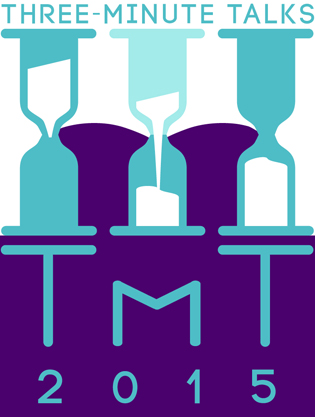Three-Minute Talks
A Short and Sweet Way to Communicate Science

Who doesn’t want to brag about their research? But how quickly can you do it? On July 16, 2015, a good-sized crowd gathered in Lipsett Amphitheater (Building 10) to watch enthusiastic fellows creatively and accurately explain their research, capture and keep the audience’s attention, use only one PowerPoint slide, and do it all within three minutes.
The Three-Minute-Talks (TmT) event evolved from the “Three-Minute Thesis” (3MT) competition that started in 2008 at the University of Queensland in Brisbane, Australia. The 3MT has since spread around the world, making its way to NIH last year: The Eunice Kennedy Shriver National Institute of Child Health and Human Development (NICHD) hosted its own version, calling it TmT, with the support of NICHD Director Alan Guttmacher and Scientific Director Constantine Stratakis.
“Dr. Stratakis was the main moving force behind TmT,” said NICHD Deputy Director, Liaison and Training, Brenda Hanning, who helped organize the event this year and last.
NICHD was already offering workshops on public-speaking and job-interviewing skills to their fellows. TmT turned out to be a popular way to enhance that training and focus on the critical importance of conveying complex science in an accessible way, to the public and even other scientists. And this year NICHD joined with the National Human Genome Research Institute (NHGRI) and the National Institute of Dental and Craniofacial Research (NIDCR) to host the second annual competition. The pre-event training included a session with a representative from the Alan Alda Center for Communicating Science at Stony Brook University (Stony Brook, New York) and two coaching sessions with communication consultant Scott Morgan, author of Speaking About Science (2006). Out of the 30 fellows who participated in the competition, 15 were chosen as finalists for July 16 event.
“I think competing with other institutes this year added energy to the process,” said Hanning.
“Everyone there gave a very dynamic talk,” said NICHD investigator Harold Burgess, who was a judge for NICHD’s semifinals competition and on hand for the finals. “They were really fun talks to go to.”
The participants were judged on how clearly and concisely they described their research to a nonexpert audience. They were also evaluated on their presentation’s logical flow, on how interesting it was, and on how well they explained the background, key findings, and significance of their work. And of course they had to do all that within three minutes.
Kathryn Tabor (NICHD), who won first place, described how she identifies misbehaving neurons in the acoustic-startle pathway in the brains of people with schizophrenia. Second-place winner was Gustavo Sudre (NHGRI), who talked about the human brain connectome’s association with attention-deficit hyperactivity disorder. Third place went to Melissa Harris (NHGRI), who described the genetic modifiers responsible for age-related graying of hair in mice. The winners will receive training-travel support and have their talks professionally produced for video.
Tabor “made it very easy for people to understand why her work was important,” said Burgess, who is also her supervisor. To that, Tabor added that “despite any butterflies, I know now that I will be able to describe the essentials of my work in an engaging [way].”
Ideas abound for next year’s competition. The institutes plan to reorganize the judging with an electronic system and give the judges a little more time to reflect on each presentation (they had only a minute per presentation this year). Burgess suggested encouraging the participants to give their talks with less reliance on their slide next time. “If you meet somebody at a dinner party or you are talking over a lunch during a meeting, you don’t have a slide,” he pointed out. “You just have three minutes to tell your story.”
Hanning hopes even more fellows will take up the TmT challenge next year.
This page was last updated on Monday, April 25, 2022
